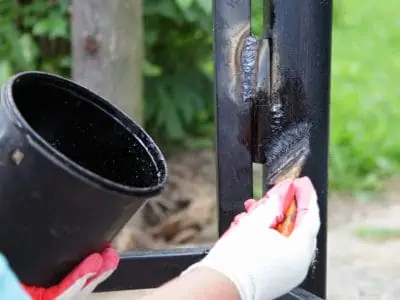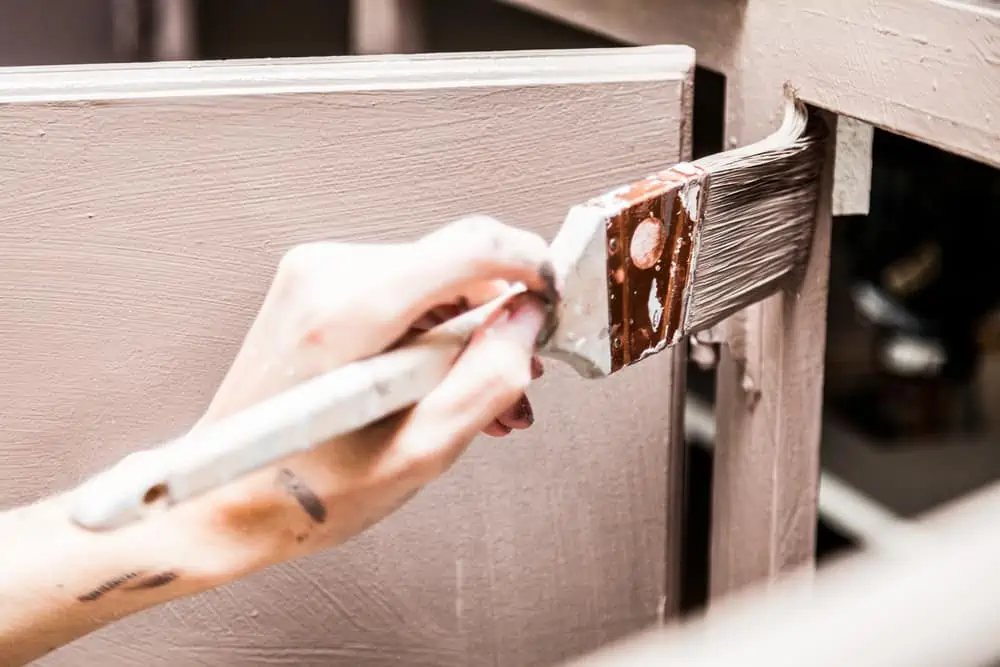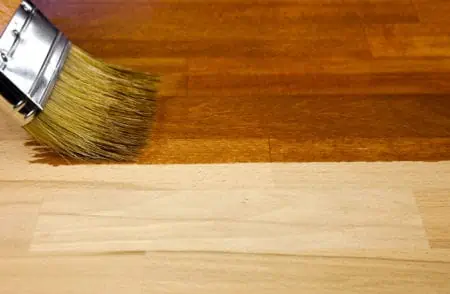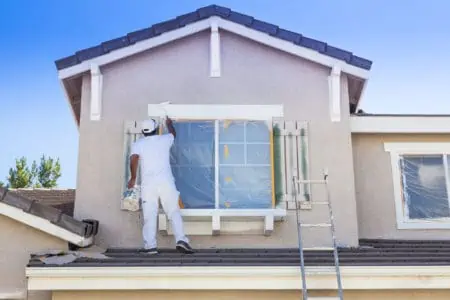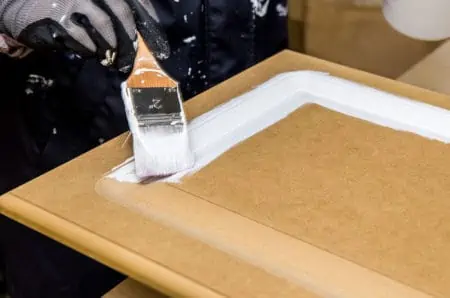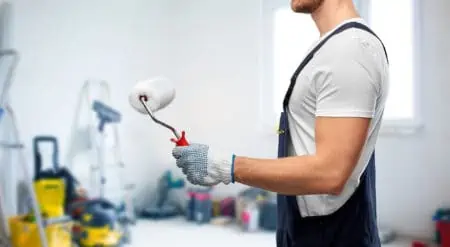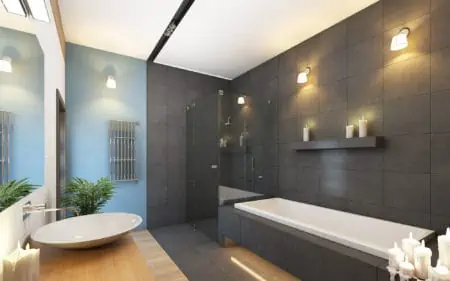Alkyd enamel paint is perfect for kitchens and bathrooms because it is hard-wearing, scratch-resistant, and dries to a hard shell. Alkyd enamel is not suitable for every surface, so knowing when and where to use it is crucial.
We explore the fascinating world of alkyd paint, reveal its best uses, and offer tips for the smoothest painted surfaces.
Key Takeaways
- Alkyd enamel paint is perfect for high-traffic areas like kitchens, bathrooms, and heavy-use furniture due to its durability and scratch-resistance.
- There are two types of enamel paint: traditional alkyd enamel (oil-based) and acrylic enamel (water-based), each having their pros and cons.
- For a smooth finish with alkyd paint, follow the grain, sand before starting, use enamel spray paint or thinner, sand between coats, and use proper brushing techniques.
- Alkyd paint typically takes between 8 and 24 hours to dry, and it’s better to wait 24 hours to ensure it’s completely dried.
What Is Alkyd Enamel Paint Used For?
Thanks to superior water resistance, alkyd enamel paint is a great choice for kitchens and bathrooms. It is suitable for any high-traffic area. Other uses include:
- Cabinets.
- Window frames.
- Doors.
- Trim and baseboard.
- Metal furniture.
- Appliances.
- Heavy-use furniture like chairs.
What Is Alkyd Enamel Paint?
Alkyd enamel paint is an oil-based product that contains a series of synthetic polyester resins. These resins are derived from various acids and alcohols. It dries super glossy, hard as nails, and it is perfect for heavy-duty uses because it is scratch-resistant.
It comes in two varieties: traditional alkyd enamel (which contains oil) and acrylic enamel. But what are the key differences between the two?
Alkyd Enamel Vs. Acrylic Enamel
Since Sherwin-Williams invented the first latex-based enamel paint in 1941, it has gone from strength to strength. Both alkyd and acrylic paint produce similar results and can be used on the same hard-wearing surfaces.
However, the differences become apparent when you dig a bit deeper.
Alkyd Enamel
The first thing to know is that alkyd enamel is an oil-based paint. This means it is super durable, suitable for most surfaces, and dries to a mirror-like finish. Oil-based enamel is also water-resistant, goes on smooth, and is self-leveling.
However, it also contains VOCs (volatile organic compounds) that release low-level ozone when the paint dries.
This is obviously bad for the environment and a potential health risk when close to the fumes. The cleanup is also more challenging because you will need mineral spirits or paint thinners.
These are also damaging to the environment, not to mention bad for your skin if absorbed.
Pros
- Hard-wearing.
- Dries super smooth.
- Highly durable.
- Water-resistant.
- Self-leveling.
- Paints on smooth.
Cons
- Contains VOCs.
- Harder to clean after use.
- Requires mineral spirits.
- Bad for the environment.
Acrylic Enamel
Acrylic enamel shares the same attributes of traditional enamel paint, but it has waterborne ingredients instead of oil. This makes it a better choice for the environment because it contains lower VOCs. Like oil-based paints, it comes in semi-gloss and gloss sheens.
Secondly, some parts of the country have banned the use of alkyd enamel, so you may fall foul of the law using it. For this reason, waterborne enamels are a natural choice because they are perceived to be safer.
They dry smooth, give a high-gloss finish, and can be used on interior and exterior surfaces. What’s more, you don’t need nasty chemicals to get the brushes clean. Soap and water will do the job admirably.
The disadvantage with acrylic enamel is in the longevity of the paint. Oil enamels could last up to 25 years, whereas latex-based paints give you 15 to 20 years of useful life. While these differences are not earth-shattering, they still exist.
It is also questionable whether water-based enamels dry to the same hard consistency. The difference in lifespan would suggest that acrylic paints are less durable.
Pros
- Better for the environment.
- Easier to clean up.
- Safer to use.
- No restricted use.
- Lower VOCs.
Cons
- Not as durable.
- Shorter lifespan.
Urethane Alkyd Vs. Silicone Alkyd
Urethane is a synthetic compound used in so many products. You find it in pesticides, fungicides, and even anesthetics. So, what does urethane bring to the party when added to enamel paint?
Urethane Alkyd
Urethane alkyd enamels are generally thicker, with a higher solids content. This means they are suitable for indoor and outdoor applications. Urethane alkyd paints are typically used in industrial or commercial settings because of their extreme durability.
You get all the advantages of alkyd enamel paint, but with increased strength. It is also easy to apply and dries super smooth. However, urethane enamel paint is generally more expensive.
Pros
- Highly durable.
- Contains higher levels of solids.
- Dries super smooth.
- Easy to apply.
Cons
- More expensive.
Silicone Alkyd
Silicone alkyd paints contain the added ingredient of silica. It makes the paint more pliable when dry, which is ideal for steel or concrete. Many maintenance paints for infrastructure, like bridges, contain silica because they resist cracking so well.
It also withstands extreme changes in temperature, which is why it performs so well in outdoor environments.
Because of its performance in extreme conditions, it is better suited to construction, and heavy industry uses. You are unlikely to need it in a residential setting.
Pros
- Resists cracking.
- Ideal for steel and concrete.
- Withstands extreme temperatures.
- Better for outdoor uses.
Cons
- Better suited for heavy construction.
How to Apply Alkyd Enamel to Furniture
Before we get into the details about applying alkyd enamel, we first need to gather the correct tools. Preparation is half the battle, and it reduces mistakes.
What You’ll Need
- Paintbrush.
- Primer.
- Sandpaper.
- Drop cloths.
- Painter’s tape.
- Enamel paint.
- Respirator.
- Mineral spirits.
- Paint stripper.
- Putty knife.
1. Choose a Well-Ventilated Space
Safety First
Alkyd paint gives off strong odors, so don your respirator and get to work in a well-ventilated area. The fumes can make you feel lightheaded, nauseous and irritate your eyes and throat.
This is more important if you are using oil-based alkyds. Water-based products contain fewer VOCs and give off fewer fumes.
2. Lay Down Drop Cloths
Painting furniture can be slightly messy. Cover your floors with old sheets or drop cloths. You only need to do this if you are painting furniture indoors.
Don’t forget to open windows and doors to let the airflow.
3. Prepare the Surface
If there is already a paint layer, remove it using sandpaper. You can use a paint stripper for thicker layers of paint. Apply it with a rag and wait for 20 minutes while the paint blisters.
Now use a scraping tool or putty knife to remove the paint. Sand the surface so that it is ready to receive the first layer of primer.
4. Time to Prime
Lay down the first layer of primer and wait the allocated time while it dries. Use fine-grade sandpaper to smooth the first coat of primer before adding a second layer. After the second load of paint dries, sand it again.
5. Apply the Enamel Paint
Now load your brush and paint on the first coat of enamel. Wait 24 hours while it dries before attempting the second layer.
Top Tip
Water-based enamels dry faster than oil-based paints. Some quote eight hours between coats, but letting the paint fully set is better.
6. Clean Up
Wash your brushes in mineral spirits and store them away to use another day.
How Long Does Alkyd Paint Take to Dry?
Alkyd paint typically takes between eight and 24 hours to dry between coats. To be on the safe side, it is better to wait for 24 hours to ensure the paint has completely dried.
How Do I Get a Smooth Finish With Alkyd Paint?
Alkyd paint dries with a mirror-like sheen, so getting the smoothest finish on your cabinets and furniture is crucial. Any imperfections will stand out, especially brush marks. So, how do you get that pro finish?
Here are a few hints and tips.
Follow the Grain
When painting wood, always work with the grain. It gives a smoother finish. The paint won’t cover as well if you try working against the grain, and the imperfections show through.
Sand Before You Start
If your wooden surface is pitted and uneven, sand it with fine-grade sandpaper to remove blemishes. A 180 or 220-grit sandpaper should give you a super smooth finish. It also creates an ideal surface for the paint.
Use Enamel Spray Paint
Using a can of enamel spray paint is ideal for metal and smaller objects. It goes on smooth, dries rock hard, and has zero brush marks. Just remember to paint in a well-ventilated area.
Use a Thinner
Enamel thinner does the opposite of hardener: it thins the paint so that it takes longer to cure. This has the added bonus of giving you more time to work the paint. It also means it liquifies so that the brush strokes disappear as the paint settles.
This Sunnyside Paint Thinner is a great option. And when you have finished, you can use it to clean your brushes.
Sand Between Coats
With standard paint, you should dry sand between coats, but with alkyd enamel, wet sanding is the correct technique. Use wet and dry, fine-grade sandpaper, like this 90-piece assorted pack. It has sandpaper ranging from 400 to 3,000-grit to ensure the smoothest finish.
Don’t Forget to Tip-Off
Tipping off is the art of running the brush the entire length of your object in a single motion. It removes blemishes and other imperfections. Hold the brush at 45 degrees, run it from top to bottom, and lift it off as it reaches the bottom edge.
Dry Brush
Dry brushing is the technique of painting the color on with one brush and performing the same procedure as tipping off, only with a clean brush. The clean brush will help pick up imperfections and spread the excess paint evenly to avoid drips.
This method works well with larger items like doors and tables.
FAQs
Enamored With Enamel
You should want your paint to be scratch-proof, durable, easy to apply, and above all, long-lasting. Alkyd enamel paint does all this and more.
It coats metal, wood, furniture, and trim. The next time you need to refresh your favorite dresser or undertake a kitchen remodel, grab a can of alkyd enamel paint. You won’t look back.
